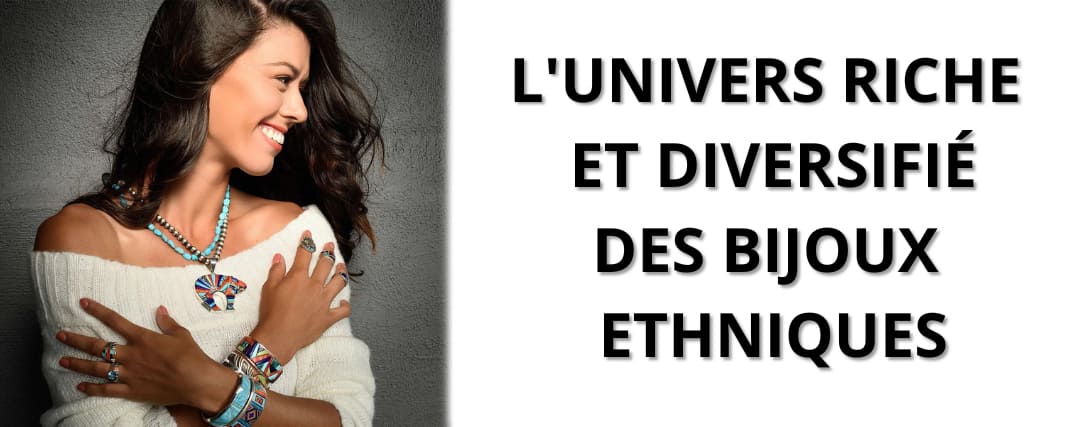Ethnic jewelry, as the name suggests, is a category of adornments deeply rooted in the cultural heritage of various societies across the world. More than just decorative pieces, ethnic jewelry often carries a wealth of meaning, reflecting the centuries-old traditions, beliefs and customs of the people who made it.
From the symbolic African beads and intricate silverware of Native American tribes to the vibrant designs of Indian Kundan jewelry, and even the mystical allure of Egyptian accessories, each ethnic piece of jewelry tells a story. It reflects the aesthetics, history and spirit of the people and their land.
In this comprehensive article, we will explore the vast spectrum of ethnic jewelry. We will travel across continents, visit diverse cultures and discover their unique jewelry styles. Whether you're a seasoned collector or a curious beginner, there's something for everyone in the captivating world of ethnic jewelry.
Understand the importance of ethnic jewelry
To understand the importance of ethnic jewelry, it is essential to appreciate their meanings beyond their aesthetic appeal. They are echoes of the ancestors and the societies in which they lived. These ornate pieces are not just accessories, they are a symbol of identity, a rite of passage and a repository of cultural heritage.
Unspoken language of identity
Each ethnic jewel testifies to the identity of its community. For example, Native American tribes often use symbols, materials, or colors specific to their tribe in their jewelry, highlighting their individual identity within the broader Native American culture. Likewise, Scandinavian jewelry with its clean, symmetrical designs and symbolic runic inscriptions tell stories of a culture deeply connected to nature and ancient mythologies.
Rites of passage and status symbols
Ethnic jewelry often accompanies crucial life events and rites of passage. African tribes, for example, have specific jewelry for events like birth, puberty, marriage and even death. In Indian culture, the 'Mangalsutra', a necklace worn by married women, is an essential symbol of marital status.
Cultural heritage and crafts
Ethnic jewelry also demonstrates human ingenuity and know-how. Take, for example, exquisite Egyptian jewelry, enriched with gold and vibrant gemstones, showcasing their advanced metallurgy skills dating back to ancient civilizations.
Sacred symbols and protective amulets
Beyond earthly matters, ethnic jewelry often has spiritual and protective meaning. Many Middle Eastern and North African cultures use the "Hamsa" or "Hand of Fatima" as a protective charm against the evil eye. Likewise, Tibetan jewelry frequently incorporates “Dzi” beads believed to provide spiritual benefits.
Social, economic and political declarations
Sometimes jewelry also becomes a powerful tool for social, economic or political statements. South African Ndebele women, for example, wear "Dzilla" rings around their necks as a symbol of their marital status and the wealth of their husbands.
In this colorful tapestry of ethnic jewelry, each thread is a story, a glimpse into a different culture and a testament to human creativity and spirit. As you go through each type, remember that these pieces are not just decorative. They are imbued with layers of meaning, making them an intriguing area of study and a joy to explore.
The different types of ethnic jewelry
As diverse as the cultures of our world are, so is the range of ethnic jewelry. Each region, each country and even each community within these areas may have their own styles, materials and jewelry making techniques. Let's embark on this journey around the world, exploring the variety and richness of ethnic jewelry.
African Jewelry: Echoes from the Cradle of Humanity
Africa, often referred to as the cradle of humanity, is home to a wide range of cultures, each with their unique expressions through jewelry. African jewelry, often made from natural materials like bones, animal teeth, shells and wood, is steeped in symbolism. Beaded jewelry is particularly common, with colors and patterns that can signify everything from tribal affiliation to social status. For example, Maasai beadwork is renowned for its intricate design and the wealth of information it contains about the wearer's age, social status, and marital status.
Native American jewelry: a story of tribes and traditions
Native American jewelry showcases the incredible diversity of different tribes. The turquoise-laden silverware of Southwestern tribes like the Navajo, Zuni and Hopi is world famous. On the other hand, plains tribes often used natural materials like bone, horn, and quills. This jewelry often features symbols of nature, such as animals and plants, reflecting the tribes' close connection to the land.
Indian jewelry: a vibrant symphony of colors and patterns
India, with its kaleidoscopic mix of cultures, gave birth to Indian jewelry which comes in many styles of jewelry. An iconic example is Kundan jewelry, originating from the royal courts of Rajasthan and Gujarat. Kundan is renowned for its intricate design, where precious stones are inlaid with gold with remarkable craftsmanship. Then there is South Indian temple jewelry, inspired by the grandeur of the region's temples and usually depicting deities or mythological motifs.
Celtic jewelry: echoes of ancient mythology
Celtic jewelry , with its intricate knot designs and symbols taken from ancient Celtic mythology, is truly captivating. The Triquetra, Celtic Cross and Claddagh ring are famous symbols, often representing ideas like eternity and love. Celtic jewelry typically features symmetrical designs, rendered in silver or gold, and sometimes adorned with precious stones.
Mexican jewelry: a fusion of pre-Hispanic and Spanish influences
Mexican jewelry beautifully merges pre-Hispanic and Spanish influences. Traditional pieces often incorporate indigenous materials like turquoise, jade and obsidian. Silver is also a key element of Mexican jewelry, especially in the famous Taxco region. Designs often draw inspiration from both indigenous symbolism and Spanish colonial influences, making Mexican jewelry a vibrant testament to the country's rich and varied history.
Asian jewelry: a wide range of styles
Asia, the largest continent, has an immense variety of jewelry styles. Chinese jewelry, for example, often features jade, considered lucky and vital. Japanese jewelry often features nature-inspired designs, created with a minimalist aesthetic. Filipino jewelry features intricate designs using pearls and gold, reflecting the natural wealth of the archipelago.
Middle Eastern jewelry: a mix of tradition and luxury
Middle Eastern jewelry is often recognized for its intricate designs and generous use of gold. Key pieces include large gold earrings, bracelets and elaborate headpieces. Protective symbols, such as the hand of Fatima or the evil eye, are common motifs. Persian turquoise, with its rich and unique blue hue, is a treasured element of the region's jewelry.
South American jewelry: a testimony to ancient civilizations and rich cultures
South American jewelry beautifully reflects the diverse cultures and rich history of the continent. The Inca and Mayan civilizations, for example, created intricate pieces from native gold, silver and precious stones, often with religious significance. Modern styles still draw on these traditional influences, while incorporating contemporary trends and techniques.
Pacific Island Jewelry: A Dance with the Bounty of the Ocean
Pacific Island jewelry is as unique and diverse as the many islands and cultures they represent. Made from the bounty of the sea, such as shells, pearls and coral, these pieces carry the spirit of the ocean. From black pearl jewelry from Tahitia to intricate shell necklaces from Hawaii, each piece is a tribute to the region's deep connection to the sea.
Australian Aboriginal jewelry: echoes of the oldest living culture
Australian Aboriginal jewelry often incorporates natural elements like seeds, shells and animal materials, reflecting the culture's deep respect for the land. An important feature of Aboriginal jewelry is its use in storytelling - each piece often carries a story or symbol from the rich tapestry of Aboriginal myths and legends.
Tibetan jewelry: a window into spiritual beliefs
Tibetan jewelry is deeply connected to the region's Buddhist beliefs. Silver and gold are commonly used, often adorned with semi-precious stones. Coins may feature symbols like the “Om” sign or the “Endless Knot.” “Dzi” beads, engraved with various designs, are often used in Tibetan jewelry for their supposed spiritual benefits.
Indonesian jewelry: a fusion of local and Hindu-Buddhist styles
Indonesian jewelry is a fascinating blend of indigenous styles with influences from the Hindu-Buddhist cultures of ancient Java and Bali. Gold and silver filigree work is common, often incorporating designs inspired by local flora and fauna. Traditional Indonesian pieces may also feature local gemstones, such as the blue-green “Bacan”.
Russian jewelry: reflection of a rich history and artistic mastery
Russian jewelry often bears a distinct blend of Western European styles with traditional Russian motifs, reflecting the country's unique historical trajectory. Intricately designed Fabergé eggs, with their elaborate details and use of precious stones, are a globally recognized symbol of Russian craftsmanship. Traditional pieces often feature exquisite glazing techniques, while Baltic Sea amber is another common component.
Scandinavian jewelry: echoes of Nordic mythology
Scandinavian jewelry or Viking jewelry, often rendered in silver, carries the striking simplicity and functionality typical of Nordic design. Viking Age artifacts include symbolic pendants representing gods like Thor and Odin. Modern designs still carry echoes of these ancient symbols, mixed with clean lines and a minimalist aesthetic. Scandinavian jewelry often features runes, the ancient Norse alphabet, adding another layer of cultural depth to these pieces.
Greek jewelry: a glimpse into an ancient civilization
Greek jewelry provides a window into one of the most influential ancient civilizations. Classic motifs like the Greek key or meander, the evil eye, and characters from Greek mythology often appear in these pieces. Greek jewelry often incorporates gold and silver, with traditional techniques like graining and filigree showcasing remarkable craftsmanship.
Inuit jewelry: homage to arctic life
Inuit jewelry reflects the life and resources of the Arctic region. Materials such as bone, ivory and native stones are often used. Arctic animals, mythological figures and symbols of the natural world usually inspire the designs. This type of jewelry, deeply rooted in Inuit tradition and environment, tells the story of a people intimately linked to the Arctic landscape.
Berber jewelry: a rich tapestry of North African tradition
Berber jewelry bears witness to the rich cultural heritage of the indigenous peoples of North Africa. Made primarily from silver, Berber pieces often incorporate vibrant enamels, exquisite filigree, and semi-precious stones like coral and amazonite. Berber designs frequently feature symbols and motifs rooted in ancient Amazigh mythology and tradition, such as the freehand cross, the representation of a free person.
Navajo Jewelry: The Spirit of Southwestern Native American Art
Navajo jewelry is known for its intricate silverwork and use of high-quality turquoise. Techniques such as sand casting and tuff casting, as well as stamping and embossing, are traditionally used to create detailed designs. Each piece reflects not only the beauty of Navajo culture, but also the deep spiritual relationship the Navajo people have with their land and resources.
Egyptian jewelry: echoes of ancient mysteries
Egyptian jewelry, dating back thousands of years, reflects one of the world's earliest civilizations. Gold was commonly used, considered the skin of the gods, and lapis lazuli represented the night sky. Ancient motifs such as the scarab, the ankh symbol and the eye of Horus featured prominently, often seen as offering protection or prosperity. Today, these ancient symbols continue to inspire modern Egyptian designs, providing a continuing connection to the country's rich past.
This is our review of the different types of ethnic jewelry around the world. We have traveled across continents, exploring the unique expressions of culture, history and art found in the jewelry traditions of each region. It is a powerful reminder of the immense creativity, rich heritage and diverse cultures that our global community embodies.
Symbolism in ethnic jewelry: deciphering a rich sign language
One of the most fascinating aspects of ethnic jewelry is the deep symbolism embedded in it. These pieces are not just decorative or functional, they often tell stories, signify status, offer protection, or serve as spiritual talismans. Although specific symbols and their interpretations vary greatly from culture to culture, understanding them can offer an enriched appreciation of these unique pieces.
Sacred geometry and symbols
Many cultures use geometry and sacred symbols in their jewelry designs. These symbols can represent religious beliefs, cultural practices or mythological stories. For example, the circular “Mandala” designs in Indian and Tibetan jewelry symbolize the entirety of the universe, while the Celtic knot, with its endless loops, signifies eternity.
Colors and materials
Colors and materials also play symbolic roles. In Chinese culture, red is considered auspicious and jade is believed to bring good luck and longevity. The Navajo people value turquoise for its spiritual meaning and as a symbol of prosperity. In Egyptian jewelry, gold represented the sun, while lapis lazuli symbolized the night sky.
Motifs relating to animals and nature
Nature-inspired designs are a common theme in ethnic jewelry. These may reflect a culture's environment or its spiritual beliefs. For example, the scarab in ancient Egyptian jewelry was a symbol of rebirth and renewal. In Inuit jewelry, animal motifs often serve as totems or spiritual guides.
Human figures and deities
Depictions of human figures and deities also have important meanings. In Indian jewelry, images of gods and goddesses are common, providing divine protection to the wearer. Similarly, the “Hand of Fatima” or “Hamsa” used in Middle Eastern and North African jewelry is believed to ward off the evil eye.
Understanding the symbolism of ethnic jewelry deepens our appreciation of these pieces, but also strengthens our connection to the cultures they represent. Now let's see how to choose the right ethnic jewelry.
How to wear and style ethnic jewelry?
Styling ethnic jewelry is a great opportunity to incorporate unique, handmade pieces into your wardrobe and celebrate the diverse cultures they represent. However, it is essential to wear these pieces with respect and appreciation, recognizing their cultural significance. Here are some tips on how to wear and style ethnic jewelry.
Consider the opportunity
To begin, consider the occasion. Some ethnic jewelry is quite ornate and might be better suited for special occasions or events. More sober pieces can be worn in more casual or everyday contexts. Remember, the key is to complement your outfit, not overshadow it.
Mix and match with care
While it is perfectly acceptable to mix and match different ethnic jewelry, avoid combining too many styles at once. The goal is to create a harmonious look that allows each piece to shine without clashing with the others.
Balance is key
Balance your jewelry with your outfit. If your clothes are patterned or colorful, consider simpler, more discreet jewelry. Conversely, if your outfit is relatively simple, a bold piece of ethnic jewelry can make a stunning focal point.
Respect the culture
Respect the culture where the jewelry comes from. Understand the importance of the pieces you wear and avoid wearing anything that could be considered sacred or ceremonial unless you are certain it is appropriate to do so.
Experiment with confidence
Finally, don't be afraid to experiment. Ethnic jewelry can be incredibly versatile and is a great way to express your personal style. Whether you wear a single piece as a statement or layer multiple pieces, wear them with confidence.
Now let's take a look at the influence of ethnic jewelry on modern fashion.
The influence of ethnic jewelry on modern fashion: a famous heritage of cultural inspiration
Ethnic jewelry has significantly influenced modern fashion trends, offering a rich mosaic of designs, techniques and cultural narratives that have been adopted by designers around the world. This influence is seen in mainstream fashion, couture collections and even in the offerings of jewelry artisans.
Cultural fusion in design
In a globalized world, the fusion of different cultural elements has become a popular design approach. Ethnic jewelry offers a treasure trove of inspiration, with its intricate designs, unique shapes and symbolic motifs translated into contemporary pieces. Designers often reimagine traditional designs in modern contexts, creating pieces that are both innovative and nostalgic.
Renaissance of traditional techniques
Ethnic jewelry has also sparked a revival of traditional craft techniques. For example, techniques such as filigree, graining, enameling, and intricate beading, which are integral to many types of ethnic jewelry, have seen a resurgence in modern jewelry making. These methods bring an element of artisanal authenticity that is much appreciated in today's fashion landscape.
Sustainability and ethical practices
Traditional practices incorporated into ethnic jewelry creation often involve sustainable sourcing and artisanal craftsmanship, aligning with the fashion industry's growing emphasis on ethical practices. This encouraged a slow fashion trend, with an emphasis on quality, sustainability and fair business practices. The appreciation of ethnic jewelry has therefore played a role in promoting these positive changes within the industry.
Trendy pieces
Some ethnic jewelry has also become trendsetters in their own right. For example, Indian “jhumka” earrings, African beads, and Navajo turquoise jewelry have all gained popularity around the world. These pieces add a distinct touch to any outfit, showcasing the wearer's appreciation for diverse cultures and styles.
A symbol of global unity
Perhaps more importantly, the influence of ethnic jewelry on modern fashion underscores a growing global unity. It means an appreciation of diverse cultures and the shared human talent to create beauty. By wearing ethnic jewelry, we not only enhance our style, but we also participate in a celebration of global cultural heritage.
Conclusion: The Endless Appeal of Ethnic Jewelry
During our journey through the fascinating world of ethnic jewelry, we explored diverse cultures, ancient traditions and remarkable craftsmanship. We delved into the rich symbolism embedded in each piece and the significant influence ethnic jewelry has had on modern fashion.
But perhaps what stands out most about ethnic jewelry is its ability to connect us with the rich tapestry of human history and shared human experience. Whether it's an intricate Celtic pendant, a piece of vibrant African beads, or an exquisite pair of Indian jhumkas, every ethnic piece of jewelry carries a story. It is a testament to the culture from which it comes, a celebration of our collective heritage and a reminder of our interdependence.
As we continue to appreciate and embrace ethnic jewelry, it is important to remember to wear these pieces with respect and understanding. Choosing and caring for these pieces is not just about style or fashion. It’s about honoring the rich cultural stories they represent.
So, whether you are an avid collector, a fashion enthusiast, or simply someone who appreciates the beauty and craftsmanship of these pieces, I hope this article has inspired you to explore more of the world of ethnic jewelry. Happy accessorizing!





